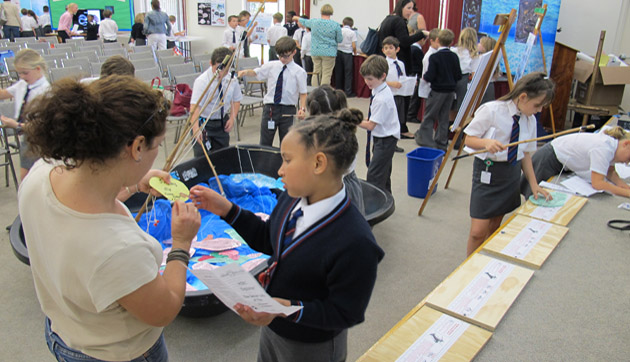Posted in:
HSBC Explorer Uncovers “The Secret Life of Fish”

Have you ever wondered how scientists can tell how old a fish is? Or what a fish’s body and tail shape can tell you about how it swims and where it lives? For many people, fish are simply what’s on the menu, but at the 2014 HSBC Explorer Program, BIOS education staff gave students and teachers the opportunity to learn about fish from nose to tail, and from the inside out.
Over a two-week period in January and February, nearly 1000 students and teachers from 20 schools visited BIOS for the annual “broadcast,” which this year featured a video about the BIOS Ocean Academy, eight learning stations, and a preview of the 2015 HSBC Explorer Program.
Kaitlin Baird, BIOS Science Education Officer, said, “BIOS was very excited to be working together with HSBC on the Explorer Program this year, which brought “The Secret Life of Fish” to students island-wide. It was a great experience to watch students engage with species they recognized and encourage them to continue to explore their own backyard.”
During the 75-minute program, students and teachers rotated through eight stations, each containing interactive and often hands-on learning activities about a specific topic related to fish and the science of studying fish, including:
- Station 1: In a preview for the 2015 HSBC Explorer Program, students watched a short clip of a remotely operated vehicle (ROV) deployment and tested their skill operating a model ROV.
- Station 2: Students “caught” paper lionfish from a pond and helped collect scientific data about each fish.
- Station 3: Using a fish ID card, students went on a virtual dive to identify and count local fish species.
- Station 4: Students learned about simple machines using a pulley system, mimicking how baited remote underwater viewing stations (BRUVS) are deployed and retrieved.
- Station 5: This microscope station gave students the opportunity to examine a lionfish tail, a black grouper jaw, and a fish scale. They also listened in on fish communication and learned how scientists age fish.
- Station 6: Students honed their fish identification skills by observing live fish in an aquarium.
- Station 7: Students viewed x-rays of fish and learned how the shapes of a fish’s head, body, and tail can tell you about its habits and ecology.
- Station 8: Featuring a live lionfish, this station also gave students the opportunity to watch a video of a lionfish eating its prey.
The new program received rave reviews from students and teachers alike, with one teacher commenting: “I applaud the BIOS group and your level of creativity and professionalism. You manage to come up with different activities year after year that wow our students. This is one of the reasons why this is a high point of our science year. I further appreciate the fact that the activities and subject matter complement our curriculum and supports and enhances what we’re doing in class.”
Students’ reactions ranged from “It was awesome because I got to learn new and different things about fish” to “Was amazing because I got to see a lionfish up close,” and included everyone’s favorite comment, “It is funner than riding on a baby unicorn.” Many students walked away from the 2014 HSBC Explorer Program with a newfound desire to go SCUBA diving and attend one of the summer Ocean Academy programs.
Ms. Baird remarked that, “The students’ enthusiasm was contagious and the energy they and their teachers bring to the BIOS staff allow us to continue to engage the primary schools in new, hands-on, and fun ways. We look forward to continuing to partner with HSBC on our next expedition!”
Tagged: